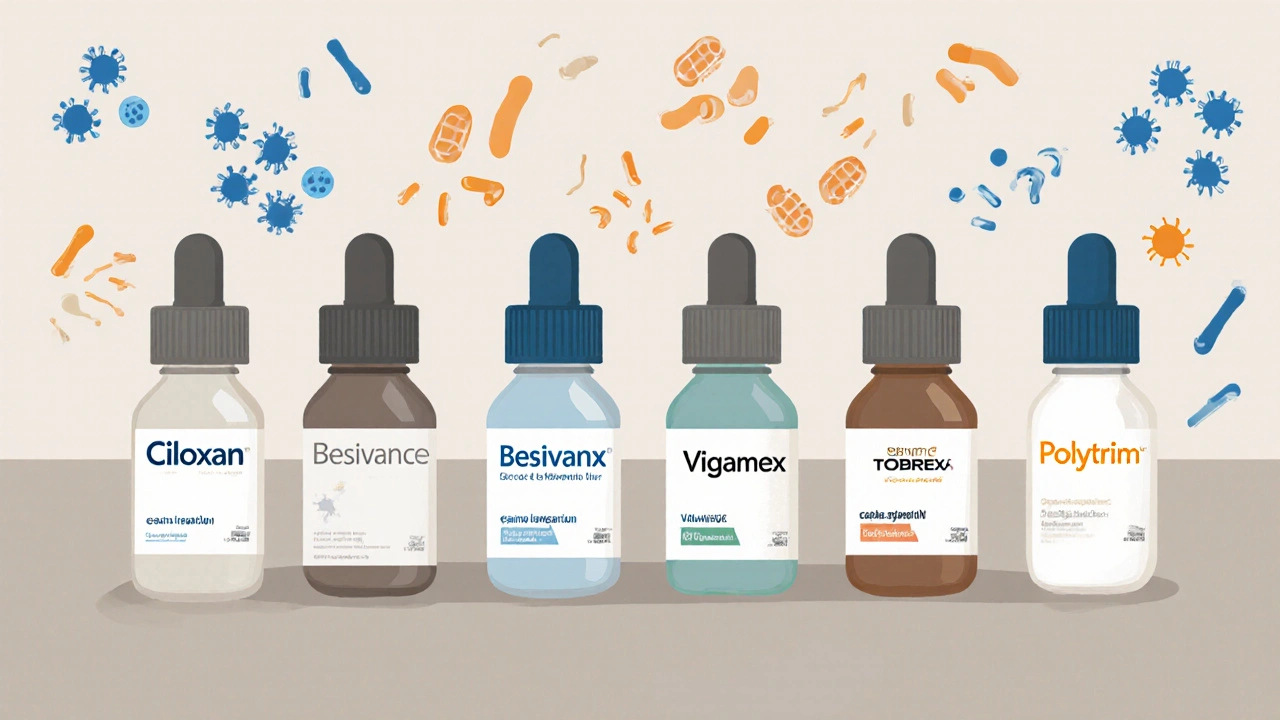Eye Antibiotic Selection Tool
Select Your Criteria
Consider: Infection type, pathogen, resistance patterns, cost, dosing convenience, and patient allergies before selecting an antibiotic.
Your Recommendation
Quick Takeaways
- Ciloxan (ciprofloxacin hydrochloride) is a broad‑spectrum fluoroquinolone ideal for postoperative eye infections and bacterial conjunctivitis.
- Newer fluoroquinolones like Besifloxacin (a chlorine‑substituted fluoroquinolone marketed as Besivance) offer stronger activity against resistant strains but cost more.
- Older agents such as Tobramycin (an aminoglycoside eye drop sold as Tobrex) are cheaper but lack coverage for Gram‑positive organisms.
- Combination drops like Polymyxin B/Trimethoprim (a dual‑action ophthalmic solution known as Polytrim) work well for mild infections but may be insufficient for severe keratitis.
- Consider infection type, resistance patterns, price, and insurance coverage before picking the right drop.
When your eye feels gritty, red, or painful after surgery, you’re probably looking for a quick, effective antibiotic. Ciloxan Ophthalmic Solution contains ciprofloxacin hydrochloride, a fluoroquinolone that targets a wide range of ocular bacteria. But the market is crowded: newer fluoroquinolones, aminoglycosides, and combination drops each claim to be the best. This guide walks through the most common alternatives, compares key attributes, and helps you decide when Ciloxan truly shines.
What Makes Ciloxan Different?
Ciloxan’s active ingredient, Ciprofloxacin Hydrochloride a synthetic fluoroquinolone approved by the FDA in 1990 for ophthalmic use, works by inhibiting bacterial DNA gyrase and topoisomerase IV. The result is rapid bacterial kill across Gram‑negative and many Gram‑positive organisms. Typical concentration is 0.3% (3mg/mL) in a sterile isotonic solution, administered one drop every two hours for the first day, then tapering over 5‑7days.
Because it penetrates the cornea well, Ciloxan is a go‑to for postoperative prophylaxis, bacterial keratitis, and acute bacterial conjunctivitis. Its side‑effect profile is mild (temporary stinging, rare hypersensitivity). The biggest drawbacks? Generic pricing is decent, but some insurers place it in a higher tier, and fluoroquinolone resistance is creeping up in certain regions.
How to Choose an Eye Antibiotic: Decision Criteria
- Spectrum of activity: Does the drug cover the likely pathogen (e.g., Pseudomonas, Staphylococcus aureus, Haemophilus)?
- Resistance risk: Local antibiograms may show rising resistance to older fluoroquinolones.
- Formulation convenience: Dosing frequency, bottle size, preservative‑free options for sensitive eyes.
- Cost & insurance: Out‑of‑pocket price varies widely; generic fluoroquinolones are cheaper than newer branded drops.
- Safety profile: Consider corneal toxicity, allergic potential, and contraindications (e.g., pregnancy).

Head‑to‑Head Comparison
| Drug (Brand) | Active ingredient | Concentration | Typical indication | Gram‑+ | Gram‑‑ | Cost (US$ per 5mL) |
|---|---|---|---|---|---|---|
| Ciloxan | Ciprofloxacin Hydrochloride | 0.3% | Post‑op, keratitis, conjunctivitis | Good | Excellent | ≈$12 (generic) |
| Besivance | Besifloxacin | 0.6% | Bacterial conjunctivitis | Excellent | Excellent | ≈$50 (brand) |
| Vigamox | Moxifloxacin | 0.5% | Keratitis, post‑op | Excellent | Very good | ≈$30 (brand) |
| Once‑Daily OFX | Ofloxacin | 0.3% | Conjunctivitis, mild keratitis | Good | Good | ≈$15 (generic) |
| Tobrex | Tobramycin | 0.3% | Gram‑negative infections, contact‑lens keratitis | Poor | Good | ≈$8 (generic) |
| Polytrim | Polymyxin B/Trimethoprim | 0.1%/1% | Mild bacterial conjunctivitis | Moderate | Moderate | ≈$10 (generic) |
Deep Dive into the Alternatives
Besifloxacin (Besivance)
Besifloxacin is a chlorine‑substituted fluoroquinolone that boasts the lowest MIC values against resistant Staphylococcus aureus and Pseudomonas aeruginosa. It’s a once‑daily 0.6% drop, which patients love for convenience. However, the price tag is steep, and insurance often places it in a specialty tier. Use it when you suspect resistant organisms or need rapid symptom relief.
Moxifloxacin (Vigamox)
Moxifloxacin offers a slightly broader Gram‑positive coverage compared with ciprofloxacin and a handy once‑daily regimen. It’s FDA‑approved for bacterial conjunctivitis and keratitis. The cost sits midway between generic fluoroquinolones and Besivance, making it a solid middle‑ground choice when price matters but you still want a strong fluoro‑agent.
Ofloxacin (generic)
Ofloxacin’s 0.3% solution is widely available as a generic, keeping out‑of‑pocket costs low. Its spectrum is comparable to ciprofloxacin, though a bit weaker against Pseudomonas. It works well for uncomplicated conjunctivitis and mild keratitis, especially in patients who can afford multiple daily doses.
Tobramycin (Tobrex)
Tobramycin is an aminoglycoside that shines against Gram‑negative bugs, especially in contact‑lens‑related infections. It lacks activity against many Staph species, so it’s not ideal for postoperative prophylaxis where mixed flora are common. The drug is inexpensive and typically dosed four times a day.
Polymyxin B/Trimethoprim (Polytrim)
This combo pairs a membrane‑disrupting peptide (polymyxin B) with a folic‑acid pathway inhibitor (trimethoprim). The synergy gives decent coverage for both Gram‑positive and Gram‑negative organisms, but the overall potency is lower than fluoroquinolones. It’s a good first‑line for mild conjunctivitis when safety and cost are top priorities.
Pros & Cons of Ciloxan
- Pros:
- Broad spectrum - hits most common ocular pathogens.
- Proven clinical data spanning 30years.
- Relatively low generic price.
- Well‑studied safety; rare serious adverse events.
- Cons:
- Twice‑daily dosing can be inconvenient for some patients.
- Increasing resistance in certain regions (especially to fluoroquinolones).
- Potential tendon‑risk warning for systemic fluoroquinolone users (though topical risk is minimal).
When to Choose Ciloxan Over Others
If you’ve just had cataract surgery or a corneal procedure, you need a drug that quickly penetrates the cornea and covers both Gram‑positive and Gram‑negative bacteria. Ciloxan fits that bill without breaking the bank. Likewise, for a patient with a known allergy to aminoglycosides or polymyxin‑based drops, a fluoroquinolone like Ciloxan is the safest bet.
On the flip side, if the infection is mild, the patient is cost‑sensitive, or you have recent local data showing high fluoroquinolone resistance, you might start with Polytrim or a cheap generic ofloxacin and reserve Ciloxan for more severe cases.

Cost, Insurance, and Access Considerations
In 2025, the average retail price for a 5mL bottle of generic Ciloxan hovers around $12 in the U.S., while the branded version sits near $25. Canadian pricing is generally lower due to provincial drug plans; many provinces list it as a Tier2 medication, meaning a modest co‑pay. For patients without coverage, pharmacies often offer a discount card that can shave $3‑$5 off the price.
Newer agents like Besivance can exceed $50, making them a second‑line choice unless the infection is resistant. Insurance formularies typically prefer generic fluoroquinolones, so prescribing Ciloxan (generic) often triggers the lowest tier.
Quick Checklist for Clinicians
- Identify infection type: postoperative, keratitis, or conjunctivitis.
- Check local resistance patterns; avoid fluoroquinolones if >20% resistance.
- Consider patient factors: allergies, dosing ability, cost.
- Start with Ciloxan for broad coverage unless contraindicated.
- Switch to a cheaper alternative if infection improves within 48hours and pathogen is known to be susceptible.
Frequently Asked Questions
Is Ciloxan safe for children?
Yes. Studies up to age 2 have shown no serious adverse effects. Use the pediatric dosing schedule (usually one drop every 4hours) and watch for stinging, which is common but temporary.
How long does a typical course of Ciloxan last?
Most regimens run 5‑7days, starting with frequent dosing (every 2hours) for the first 24‑48hours, then tapering to 4‑6 times a day.
Can I use Ciloxan if I wear contact lenses?
It’s best to remove contacts during treatment and wait at least 24hours after finishing the drops before reinserting them. This reduces the risk of trapping bacteria under the lens.
What are the signs that I need a stronger antibiotic than Ciloxan?
If pain worsens after 48hours, vision becomes blurry, or there’s a growing white spot on the cornea, consider a culture and switch to a higher‑potency fluoroquinolone (e.g., Besifloxacin) or an agent with better Pseudomonas coverage.
Does using Ciloxan increase the risk of tendon injury?
Topical use has a negligible systemic absorption, so tendon rupture is extremely rare. The warning primarily applies to oral or IV fluoroquinolones.
Next Steps
Talk to your eye care professional about the specific infection you’re dealing with. Bring up any cost concerns - many pharmacies can offer a generic cutter that makes Ciloxan even more affordable. If you’ve tried Ciloxan and symptoms persist, ask for a culture and consider stepping up to a newer fluoroquinolone or a combination drop.
Remember, the right antibiotic depends on the bug, the patient’s situation, and the price tag. Use this comparison as a roadmap, not a prescription, and you’ll land on the most effective, budget‑friendly option for your eyes.






Warren Nelson
October 12, 2025 AT 17:03I've been using Ciloxan for post‑op cataract cases for a few years now, and the regimen of every two hours the first day works like a charm. The drop penetrates the cornea quickly, so patients notice reduced redness within 24 hours. Compared with a generic ofloxacin, the cost difference is barely a couple bucks and the coverage feels broader, especially against Pseudomonas. I also appreciate that you can switch to a cheaper generic once the infection settles, saving insurance dollars. Overall, it's a solid first‑line pick unless you have a known fluoro‑resistance problem in your area.
Jennifer Romand
October 19, 2025 AT 19:06Behold, the grand stage of ocular pharmacology, where Ciloxan waltzes in with the swagger of a seasoned virtuoso, outshining its humble counterparts with a spectrum as vast as a sunrise over the Pacific. Yet, one must not be blinded by its brilliance; the looming specter of fluoroquinolone resistance stalks the periphery like an uninvited guest at a gala. The price, though modest, can still echo in the pockets of the uninsured, whispering temptations of cheaper alternatives. In the theater of eye care, every drop must earn its applause, lest it be relegated to the footnotes of forgotten prescriptions.
Kelly kordeiro
October 26, 2025 AT 21:06In the annals of contemporary ophthalmic therapeutics, the ciprofloxacin‑based formulation known as Ciloxan occupies a position of both historical significance and modern relevance. Its molecular architecture, a fluoroquinolone scaffold endowed with a 3‑methyl‑piperazine side chain, confers an affinity for bacterial DNA gyrase that rivals even the most contemporary quinolones. Clinical trials conducted in the early nineties demonstrated a bactericidal efficacy against a panoply of ocular pathogens, ranging from Staphylococcus aureus to Pseudomonas aeruginosa, thereby establishing its broad‑spectrum credentials. The pharmacokinetic profile reveals rapid corneal penetration, a characteristic that is indispensable for the management of post‑surgical prophylaxis where time is of the essence. Moreover, the 0.3 % concentration ensures a therapeutic window that balances potency with ocular tolerability, mitigating the stinging sensation that plagues many other agents. Economically, the generic incarnation of Ciloxan commands a market price that hovers near twelve dollars per 5 mL vial, a figure that remains palatable for the majority of insured patients. Nevertheless, one must remain vigilant to the insidious rise of fluoroquinolone resistance, a phenomenon documented in regional antibiograms across both metropolitan and rural settings. The propensity for resistance emergence is accentuated in environments where sub‑therapeutic dosing persists, underscoring the necessity of strict adherence to the prescribed regimen. In contrast, newer fluorinated analogues such as besifloxacin proffer superior minimum inhibitory concentrations, albeit at a cost that exceeds forty dollars per bottle, rendering them suitable primarily for recalcitrant or resistant infections. The decision matrix, therefore, should incorporate not only microbial susceptibility patterns but also patient‑specific factors such as allergy history, cost constraints, and dosing convenience. For individuals allergic to aminoglycosides or polymyxin‑based combinations, Ciprofloxacin remains a safe alternative devoid of cross‑reactivity. Conversely, in cases of contact‑lens‑associated keratitis where Pseudomonas predominates, the clinician might favor tobramycin or besifloxacin for enhanced Gram‑negative coverage. From a safety standpoint, topical application of Ciprofloxacin is associated with a negligible systemic absorption, obviating the rare but serious tendon toxicity that has been observed with oral fluoroquinolones. Patient education, therefore, should emphasize the transient ocular discomfort that may accompany instillation while reinforcing the importance of completing the full course to avert relapse. In summation, Ciloxan embodies a judicious balance of efficacy, affordability, and tolerability, rendering it an appropriate first‑line choice for a majority of uncomplicated ocular bacterial infections, provided that local resistance trends are conscientiously monitored.
Chris Fulmer
November 2, 2025 AT 23:06Resistance patterns can vary widely, so checking your local ophthalmology antibiogram before settling on a fluoroquinolone is a smart move. In regions where fluoro‑resistance exceeds 20 %, I’ve started with a combination drop like Polytrim and only switch to Ciloxan if the culture shows susceptibility. It also helps to counsel patients on proper drop technique to avoid sub‑dosing, which is a common driver of resistance.
William Pitt
November 10, 2025 AT 01:06If you’re juggling cost and convenience, start with the generic Ciloxan for the first few days, then reassess. Many insurers will cover the switch to a cheaper OFX generic once the eye looks better, saving the patient some cash without sacrificing efficacy. Encourage patients to keep a dosing schedule on their phone; the reminder can make the difference between a quick recovery and a prolonged infection.
Jeff Hershberger
November 17, 2025 AT 03:06The market inundation of ocular antibiotics sometimes feels like a lexical labyrinth, yet Ciloxan remains a relatively unpretentious protagonist in the script. Its spectrum is commendable, but the looming specter of resistance casts a subtle pallor over its otherwise bright performance. Pragmatically, reserving it for cases where broad‑coverage is indispensable avoids unnecessary selection pressure.
Brad Tollefson
November 24, 2025 AT 05:06Ciloxan’s dosing schedule may appear cumbersome, but adherence is key to preventing relapse.
Paul van de Runstraat
December 1, 2025 AT 07:06Oh, absolutely, because who doesn’t love a five‑times‑daily ritual that feels like watering a cactus?
Lewis Lambert
December 8, 2025 AT 09:06When choosing an eye drop, think of it as assembling a toolbox: you need the right screwdriver (spectrum), the right wrench (dosing), and the right budget (cost). Ciloxan offers a solid screwdriver that fits most screws, especially after surgery where mixed flora are the norm. If the patient can tolerate twice‑daily dosing and isn’t allergic to aminoglycosides, it’s a safe bet. For milder cases where cost is the primary concern, a generic ofloxacin or Polytrim can do the job. Always verify local resistance trends; a high fluoroquinolone resistance rate nudges you toward alternatives like besifloxacin. Remember to educate patients on removing contact lenses during therapy, as lingering lenses can harbor bacteria. Finally, schedule a follow‑up in 48 hours to ensure the infection is responding, and adjust the regimen if needed.